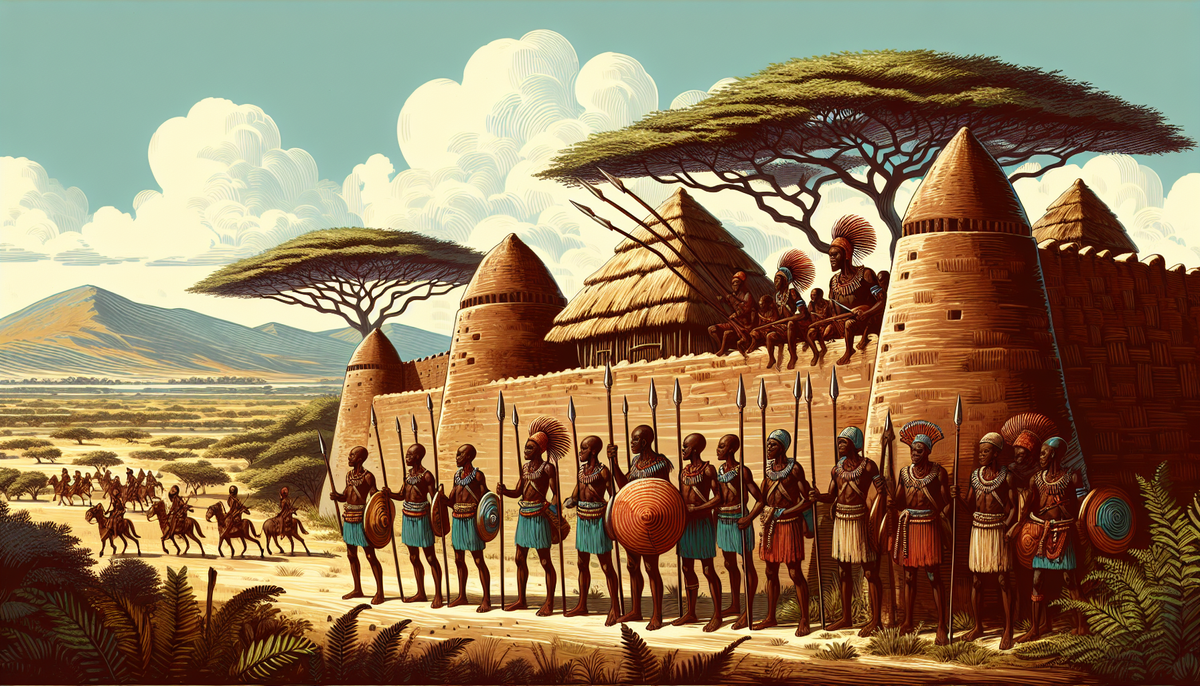Militarization and Defense Strategies in Pre-Colonial African Kingdoms

Overview of Military Significance in African Societies Before Colonial Influence
Before the onset of colonial rule, military power held a crucial role in the political and social fabric of African kingdoms. The effectiveness of armed forces was often synonymous with a kingdom's ability to maintain sovereignty, assert territorial claims, and protect its people from external threats. Warfare was not merely a means of conflict; it was instrumental in shaping alliances, securing resources, and consolidating power among various tribes and kingdoms.
In many societies, military prowess was celebrated and revered, often woven into the cultural identity of the people. Warriors were not only defenders but also played vital roles as enforcers of law and order within their communities. Recruitment and training of soldiers were prioritized, with various age groups participating in military drills and ceremonies that cemented their roles as defenders.
Furthermore, military organization extended beyond the battlefield, influencing governance and administration. Royal leaders often relied on their strongest warriors for counsel and aid in decision-making processes. The strategic deployment of military forces also allowed kingdoms to engage in trade, diplomacy, and territorial expansion, highlighting the multifaceted significance of militarization in sustaining the vitality of pre-colonial African societies.
Weapons and Warfare Techniques Across Various Kingdoms
In pre-colonial Africa, diverse kingdoms developed a range of weapons and warfare techniques that reflected their unique environments, cultures, and needs. The armaments included spears, bows, swords, and shields, each crafted from locally sourced materials like wood, iron, and leather. For instance, the Zulu of Southern Africa are renowned for their short stabbing spear, the ukukhu, which allowed for close combat efficiency, while also employing large, oval shields for protection.
In contrast, the Kingdom of Mali utilized archery and heavy cavalry, leveraging horses imported from North Africa. The integration of cavalry into warfare allowed for swift maneuvers and the ability to cover large territories quickly during raids or defensive operations. Techniques also varied based on combat styles; the kingdom's hunters incorporated strategies from animal tracking into their warfare, providing tactical advantages in knowledge of the terrain.
Siege tactics were another significant aspect, particularly for fortified cities. Kingdoms like Great Zimbabwe built formidable stone walls, necessitating innovative strategies from attackers. Psychological warfare, utilizing deception and the element of surprise, played a vital role across various cultures. Overall, the evolution of weapons and techniques was a reflection of each kingdom's adaptability and resilience in the face of conflict.
Strategic Alliances and Diplomacy Among Neighboring Tribes
In pre-colonial Africa, strategic alliances and diplomacy were essential for survival and prosperity among neighboring tribes. Conflicts were common due to competition over resources, territory, and prestige. However, many kingdoms recognized that cooperation could be more beneficial than constant warfare. Diplomatic relations often involved formal agreements to establish peace, trade, and mutual defense against external threats.
Negotiations were conducted through envoys or chieftains who would engage in discussions to resolve disputes or forge alliances. These gatherings sometimes included rituals or ceremonies, reinforcing social bonds and ensuring the legitimacy of agreements. For instance, the Kingdom of Ghana formed various alliances with neighboring tribes to shield itself from more powerful adversaries, allowing them to stabilize political relations in the region.
The influence of marriage played a significant role in diplomacy, as royal families married into neighboring tribes to solidify ties and create loyalty. This practice helped promote peace as well as secure political allegiance, transforming personal relationships into broader political strategies.
Consequently, alliances could result in collective military actions, enabling tribes to coordinate their efforts against common enemies. This dynamic interplay of diplomacy and kinship contributed to a complex web of relations that defined the socio-political landscape across African regions before colonialism.
Role of Spiritual and Cultural Practices in Battle Preparation
In pre-colonial African societies, spiritual and cultural practices were deeply intertwined with military endeavors, shaping the rituals and preparations for battle. Warriors engaged in various spiritual ceremonies to invoke protection, guidance, and favor from ancestral spirits or deities before heading into combat. These practices created a sense of unity and purpose among troops, reinforcing their commitment to their cause and each other.
Rituals often included sacrifices of livestock or offerings to ancestral altars, symbolizing respect and seeking blessings for victory and safety. Diviners and spiritual leaders played a critical role in interpreting omens or signs and offering counsel on when to engage in battle, often consulting with the spirits to determine the right path. Additionally, song, dance, and storytelling served as mediums for transmitting valor, history, and traditions, instilling pride among warriors and rallying them for combat.
Cultural symbols, such as amulets or markings, were often worn as talismans for protection against harm. These spiritual dimensions helped create a psychological edge, as soldiers believed they were backed by divine forces. This multifaceted approach not only prepared warriors physically and mentally but also deepened the connection between cultural identity and the duty of defending their communities against perceived threats.
Impact of Terrain and Geography on Defensive Measures
Terrain and geography played a pivotal role in the defensive strategies of pre-colonial African kingdoms. The natural landscape often dictated the effectiveness of military tactics and fortifications. For example, mountainous regions offered natural barriers that facilitated the establishment of strongholds and lookout points, allowing defending forces to monitor enemy movements and mount surprise attacks. The Kingdom of Aksum skillfully utilized its elevated plateaus to protect its capital, making it difficult for invaders to approach undetected.
In contrast, flat plains required different defensive approaches, such as forming large formations of warriors to counter enemy advances. Riverways could serve as both barriers and avenues of access, influencing where tribes chose to engage in combat. Kingdoms like the Mali Empire harnessed strategic waterways to transport troops and supplies while providing a means to fend off invaders.
Deserts posed unique challenges, compelling communities to utilize mobile tactics and guerilla warfare, making use of natural cover like dunes. The ability to adapt to diverse environments ensured a kingdom's survival and resilience. Ultimately, an understanding of terrain not only informed military strategies but also shaped the construction of fortified settlements, enhancing the overall capacity of societies to defend themselves against external threats.
Evolution of Military Leadership and Training Methods
The evolution of military leadership and training methods in pre-colonial African societies was marked by adaptability and innovation, often reflecting the complexities of inter-tribal warfare and resource management. Initially, military leaders emerged from respected lineages, often possessing both martial prowess and strategic acumen. Over time, leadership qualities began to extend beyond noble birth, spotlighting individuals who demonstrated exceptional tactical skills or innovative strategies during conflicts.
Training methods evolved to cultivate these leaders and their forces. Young warriors underwent rigorous physical training, emphasizing endurance, agility, and tactical mastery. Initiation rituals often included training in weapons handling and simulated combat to instill discipline and camaraderie. For instance, the Maasai incorporated both physical prowess and spiritual teachings into their warrior training, reflecting the cultural significance of their military practices.
The use of mentorship also became a hallmark of military evolution, where seasoned warriors guided younger recruits, sharing vital knowledge about warfare, strategy, and the importance of unity. Tactical evolution embraced diverse combat styles, integrating lessons learned from past encounters. This approach enriched military doctrine, allowing societies to adapt to changing circumstances effectively. Ultimately, the continuous development of leadership and training underscored the crucial link between military efficacy and societal cohesion in pre-colonial Africa.
Examples of Notable Battles and Campaigns in Pre-Colonial Africa
Pre-colonial Africa was marked by significant battles and campaigns that demonstrated the military prowess and strategic ingenuity of various kingdoms. One notable example is the Battle of Isandlwana in 1879, part of the Anglo-Zulu War. The Zulu forces, armed primarily with traditional weapons, achieved a stunning victory against British troops equipped with modern firearms. This battle showcased the effectiveness of the Zulu military organization and tactics, emphasizing mobility and surprise.
Another pivotal conflict was the Battle of Adwa in 1896, where Ethiopian forces led by Emperor Menelik II defeated Italian colonial forces. This decisive victory secured Ethiopia's sovereignty and marked a significant moment in African resistance against colonialism, inspiring subsequent liberation efforts across the continent.
The Shona Wars in modern-day Zimbabwe illustrate the complexity and scale of conflict during the late 19th century. The Shona people mounted formidable resistance against colonial expansion, employing guerilla tactics and utilizing the dense terrain to their advantage.
These examples underscore not only the varied military practices across different regions but also the broader implications of these conflicts as they shaped the political landscapes of African societies long before colonization. Each battle encapsulated a blend of bravery, strategy, and cultural significance, leaving a lasting legacy in African history.



